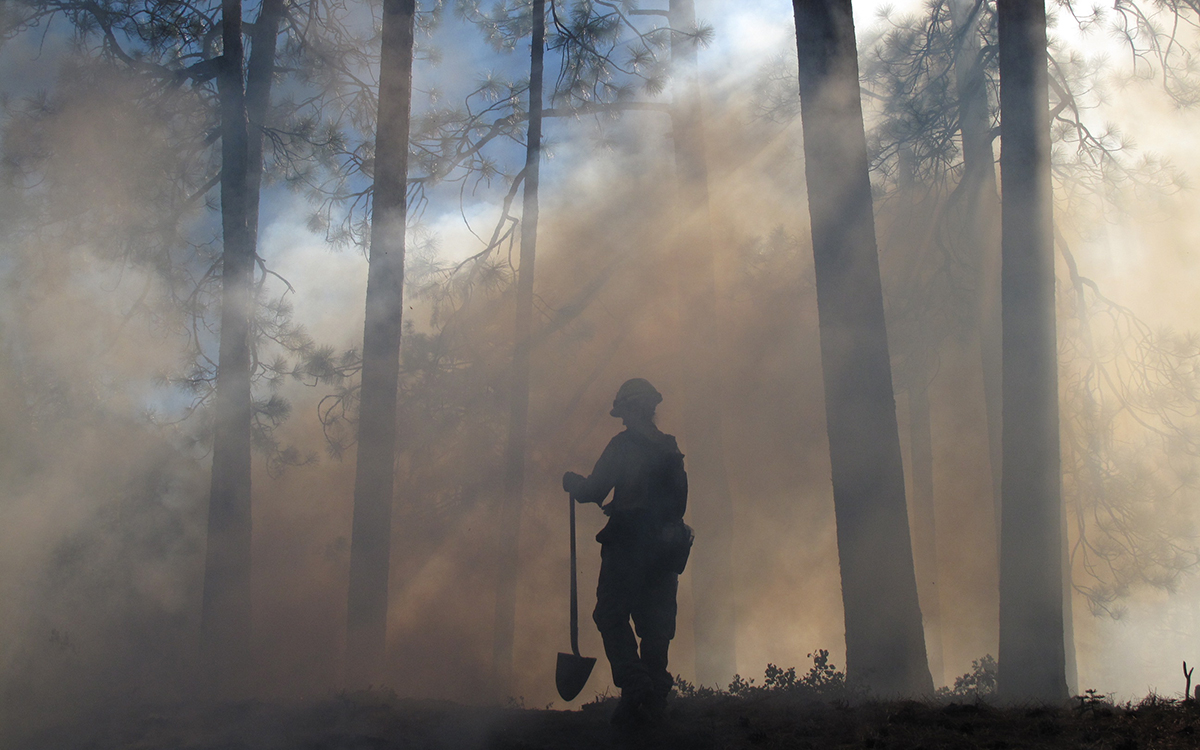Is Florida the Answer to California’s Fire Problem?
A visit to the state where almost every day is a fire day

During the winter, prescribed fire is used to restore and maintain Northern California's oak woodlands. | Photo courtesy of Lenya Quinn-Davidson
Every year in early spring, Lane Green sets half of his property—100 acres of longleaf pine forest in the Red Hills region of the Florida Panhandle—on fire. Green, 73, has been burning this land since the time he learned to walk. His father would jury-rig a torch using a wire hanger and piece of cloth and tell him to drag it through the brush along the road—just as Green’s father had been taught before him, his granddad before him, and his great-granddad before him. When Green was young, his favorite time to burn was at night, when the air was cool, and the fire, creeping and crackling, looked as if the stars had been scattered across the ground.

Florida's longleaf pine forests depend on frequent fire to knock back competing plants. | Photo courtesy of David Godwin
“The fire culture has always been here,” said Green, the former director of the Tall Timbers Research Station, where the study of fire ecology was born in 1958. “There’s no place in Florida where fire is not an accepted practice.” Green said that before Europeans colonized the area, Native Americans used fire to manage longleaf pine forests and attract game. In the chronicles of his expedition to Florida in 1539, the Spanish explorer Hernando de Soto writes of woodlands so open that entire armies, including cavalry and supply wagons, could march through them unencumbered. After most of the land was violently taken from its Indigenous residents, Spanish ranchers and, eventually, American farmers, continued burning. They never stopped.
Scientists and land managers almost universally agree that prescribed fire is the single best tool available to help mitigate wildfire risk. Landowners in the American Southeast use more prescribed fire than in any other part of the country. But across much of the American West—which has captured an outsize proportion of the public imagination around wildfire—scientists say land management agencies aren’t using fire nearly enough.
In 2017, federal and state forest managers, ranchers, and private property owners in Florida, which many fire scientists consider the prescribed fire capital of the country, burned more than 2 million acres, according to data compiled by the nonprofit Climate Central. That same year, California—which is twice the size of Florida and has six times more acres in public land—burned less than 50,000 acres. Oregon burned 48,000, Idaho 33,000, Montana 24,000, and Nevada 5,000.

At the University of Florida's Ordway-Swisher Biological Station, prescribed fire is used throughout the year. | Photo courtesy of David Godwin
Like in Florida, Native American cultures throughout the United States used fire to manage the land. But in the West, much of the land taken from Indigenous groups was redrawn as public “forest preserves.” In the absence of Native American land management, many of the places where they had previously used fire to clear the landscape became dense and overgrown. In 1910, a series of wildfires burned more than 3 million acres of forest in Montana, Idaho, and Washington. Known collectively as the Big Blowup, the blazes spooked the nascent US Forest Service into adopting a policy that demanded all fires be put out by 10 A.M. the day after they were reported. Because much of this land was publicly owned, federal land management agencies could efficiently enforce this policy of suppression.
In southeastern states, such as Florida, where most forestland is privately owned, people simply never stopped burning it. Even the US Forest Service in the Southeast dabbled with prescribed fire—the first-ever lit on federal land was in Osceola National Forest in 1943.
Property owners like Green are supported by a host of laws that recognize fire’s ecological necessity and enshrine a person’s right to burn. In 1990, Florida lawmakers passed a bill declaring prescribed fire “a land management tool that benefits the safety of the public, the environment, and the economy of the state.” Florida was the first state in the country to pass a “gross negligence” law, which protects landowners from liability if a fire gets out of control. Laws like these could be a model for what fire management throughout the country could look like.

Fire is a "common denominator" in the South; universities, nonprofits, and public agencies come together to burn. | Photo courtesy of David Godwin
“Prescribed fire is not just an accepted practice in the Southeast,” said David Godwin, an expert in fire ecology at the University of Florida and director of the Southern Fire Exchange. “It is how we manage ecosystems. It is our number one tool for managing and improving wildlife habitat, and it is our number one tool for reducing wildfire risk at the landscape scale.”
Still, says Godwin, Florida and California have very different landscapes and weather. While some ecologists say the best time to burn in Florida is in the spring and summer (lightning strikes, the state’s natural fire starters, peak in June), the near certainty that a thunderstorm is just a few days away makes it safe for landowners to burn year-round. With its long, wet winters and hot, dry summers, California has two short burn windows, in the spring and fall, when the land is dry enough to hold a flame but damp enough that it’s not likely to burn out of control.

Prescribed fire is used on California's coastal grasslands. | Photo courtesy of Lenya Quinn-Davidson
California is home to almost 200 unique ecosystems and landscapes. While nearly all of them burn, they each burn in their own way and on their own time. The problem is, the entire state operates under one uniform fire management system. It can be hard to get a prescribed burn approved in one part of the state if another is on fire watch. For example, the best time to burn in Northern California is often in October, just when regions to the south are worried most about wildfires. A red flag warning in Butte County, in the Sierra Nevada foothills, can stymie a prescribed burn hundreds of miles away in Humboldt County, near the ocean.
Geography and topography are also complicating factors. The upland forest ecosystem on Green’s property in the Florida Panhandle, also known as a pine flatwood, is, well, flat, which makes fire easier to control. Most of the terrain in need of burning in California is steep and mountainous. Just like a flame creeps up a matchstick when lighting a candle, the flames from a prescribed burn will race uphill. Keeping a fire under control in such an environment requires back-breaking effort. For much of Florida, a peninsula with the Gulf of Mexico to its west and the Atlantic Ocean to its east, a steady breath of wind blows most smoke produced during prescribed fires out to sea. In the mountainous West, smoke from prescribed fires can settle into valleys, choking residents for days or weeks.
For some of these reasons, getting permits for prescribed fire in the West can be prohibitively expensive. In California, an air quality permit can range from under $40 to as high as $1,250. To burn during the fire season—from May through October—you also need a permit from the California Department of Forestry and Fire Protection, or Cal Fire. For a 300-acre burn, Cal Fire might require three fire engines and for as many as 30 people to be on-site. Lenya Quinn-Davidson, an area fire adviser for the University of California Cooperative Extension, said that, apart from being maddening to organize, this can add up to thousands of dollars a day.
The biggest hurdle for those who want to burn in California is that firefighters have a near monopoly on prescribed fire, Quinn-Davidson said. “There’s a lot of ownership by the fire-suppression community over prescribed fire. It’s this culture of, ‘We’re the experts; we’re the only ones who know how to use it, and we’re the only ones who should use it.’ But they don’t have time to use it because they’re too busy fighting fires.”
In the Southeast, a coalition of prescribed fire councils, which bring together federal and state land managers, foresters, air quality regulators and private landowners, help advocate for prescribed fire in their states, and educate residents. Godwin, the University of Florida fire ecology expert, said prescribed fire councils help private property owners incorporate new fire science into their land management decisions. The Northern Florida Prescribed Fire Council helped advocate for Florida’s prescribed burn laws in the 1980s and '90s. In 2009, Quinn-Davidson formed the Northern California Prescribed Fire Council—the first in the West. Others have been following ever since. Oregon created one in 2014. Nevada in 2017.

The Northern California Prescribed Fire Council hosted the state's first training program in October 2013, at the Whiskeytown National Recreation Area. | Photo courtesy of Lenya Quinn-Davidson
Private land managers in California are slowly learning how to utilize prescribed fire within the confines of the state’s geographic guardrails. California’s strict air quality standards, once considered a major impediment to prescribed fire, have become less of a problem, as those who want to burn are building relationships with local air quality districts, and regulators realize that not allowing prescribed fire can make air quality even worse in the long run. For example, in November 2018, smoke from the Camp Fire poured into the San Francisco Bay Area. For a few days, air pollution levels were among the worst in the world.
Last year, influenced by Florida’s prescribed burn law, California state legislators passed Senate Bill 1260, which mandates Cal Fire to create a training program for anyone who wants to become a “state-certified burn boss.” The law doesn’t provide complete liability protection the way that it does in the Southeast, but those who become certified will have the option to “share” liability with Cal Fire.
“The cool thing about this law is that it’s meant for people who aren’t professional firefighters,” said Quinn-Davidson, who is now on the team developing a curriculum for the new training program.“Cal Fire is uncomfortable with it, but it’s going to happen. We’re going to see people say, ‘Yeah, I’m a certified burn boss, and I never fought fires.’”
This article has been modified since publication.
 The Magazine of The Sierra Club
The Magazine of The Sierra Club



